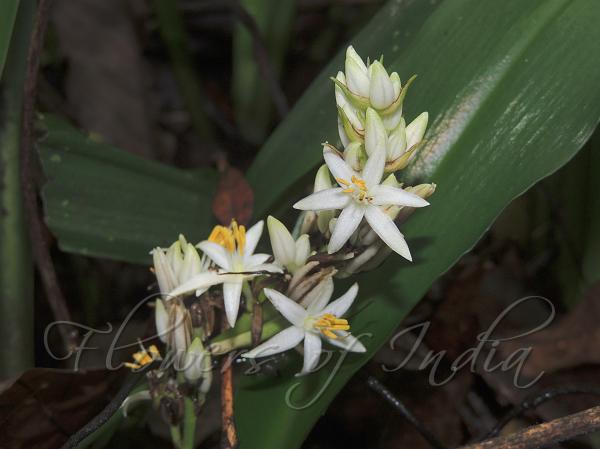|
| Assam Chlorophytum |
|

|

| File size | 471471 |
| Original date | 5/24/18 11:21 AM |
| Resolution | 2048 x 1536 |
| Flash | Flash fired |
| Focal length | 13.3mm |
| Exposure time | 1/60s |
| Aperture | 3.9 |
| Focus Distance | |
| Metering Mode | Multi-segment |
| Camera make | NIKON |
| Camera model | COOLPIX P510 |
| Sensor type |
|
|
|
|
Photo: |
Botanical name: Chlorophytum assamicum Family: Asparagaceae (Asparagus family)
Assam Chlorophytum is a newly discovered (2019)
perennial terrestrial rosette-forming herb, erect or nearly erect.
Leaves are up to 45 cm long, stalkless, in a rosette, 6-12 in a plant,
spreading, overlappinh at base. Leaf blade is 15-45 x 5-6 cm, broadly
lanceshaped, margin entire-hyaline, slightly wavy, tapering, base
gradually narrowed down, green, leathery. Both surfaces are hairless,
veins 24-28, parallel. Flowering stem is solitary, unbranched,
flower-cluster-stalk 17-25 cm long, round, hairless, without
intermediate node, raceme 5-6 cm long, about one fourth the length of
the flowering stem; lowermost bract sterile, larger than others, 6-7 x
0.25-0.35 cm, fertile bracts 1-2 x 0.5-0.6 cm, thinly herbaceous,
margin hyaline-translucent, soon withers. Bracteoles are 3, recurved,
triangular-ovate,1-5 x 1-3 mm. Flower-stalks are 1-3 to a node, 0.6-0.8
cm long, round, hairless, greenish white, without an articulation.
Flowers are 1.3-1.8 cm across. Tepals are in two whorls, free, white,
1.1-1.3 x 0.3-0.4 cm, ovate lanceshaped, blunt, veins obscure. Stamens
are in two whorls, 0.8-1.1 cm long, erect; style 1, at branch-ends,
1-1.4 cm long, straight, white, hairless. Assam Chlorophytum is found
in Behali Reserve Forest, Sonitpur district of Assam. Flowering:
April-May.
| Identification credit: Dipankar Borah | Photographed in Behali Reserve forest, Assam. |
• Is this flower misidentified? If yes,